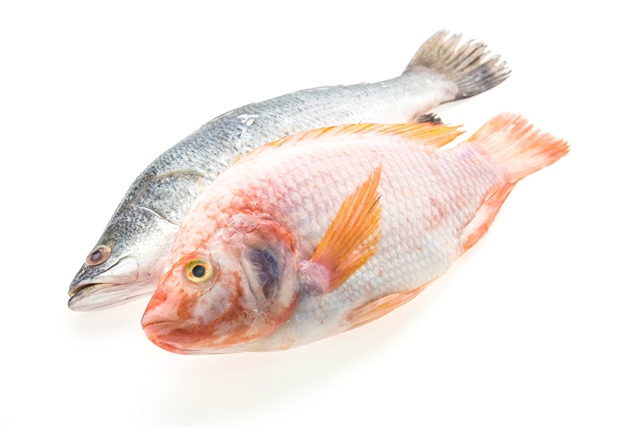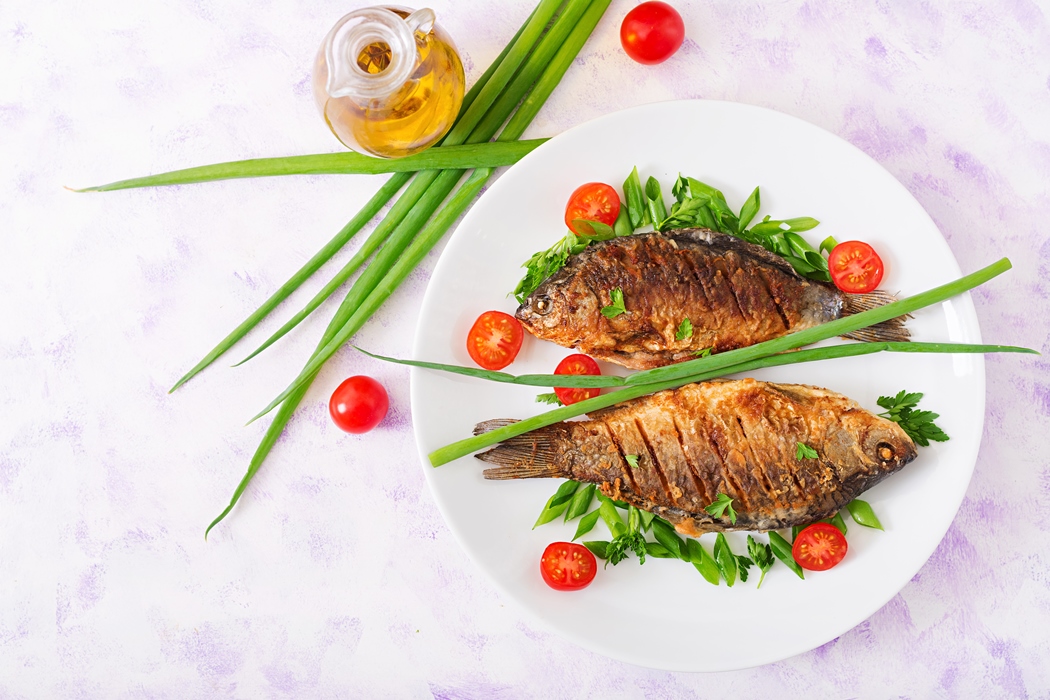 What is the best way to cook fish? Look no further than our 2021 updated guide to the perfect oven-baked fish recipe.
What is the best way to cook fish? Look no further than our 2021 updated guide to the perfect oven-baked fish recipe.
Cooking fish is one of the easiest ways to starting to introduce a healthy alternative to meal times.
If you’re not quite ready to go fully vegetarian at dinner time just yet but still want a nice alternative to meat in order to balance out your diet, fish is the best way to go.
But, what is the best way to cook fish?
Well, as you can imagine, there are a number of different ways to do so. Boiling, frying, grilling, or poaching all bring out different flavors and textures but, today, we’re going to run you through the perfect way to bake fish in an oven.
Never be scared when cooking fish.
Sure, some kinds can look pretty dainty and you may feel the power of an oven can obliterate it into smithereens but, with the right direction, it’s one of the easiest ways of preparing fish.
So, without further ado, here’s our perfect oven-baked fish recipe.
Oven-Baked Fish Recipe – Quick List
● 8 tablespoons of salted butter
● 4 minced garlic cloves
● 2 lemons (cut into slices)
● 3 pounds of white fish (any of cod, sole, haddock, pollock)
● 1 tablespoon kosher salt
● 1 tablespoon freshly ground black pepper
● A handful of minced parsley (to taste)
Table of Contents
Oven-Baked Fish Cooking Time
- Prep time: 5 minutes
- Cooking time: 10 minutes
- Total: 15 minutes
Oven-Baked Fish Recipe (2 servings, half recipe for 1 serving):
- 8 tablespoons of salted butter
- 4 minced garlic cloves
- 2 lemons (cut into slices)
- 3 pounds of white fish (any of cod, sole, haddock, pollock)
- 1 tablespoon kosher salt
- 1 tablespoon freshly ground black pepper
- A handful of minced parsley (to taste)
Optional
- 1 tablespoon of dill/paprika/thyme/rosemary/basil
Oven-Baked Fish With Garlic Lemon Butter Instructions
- Pre-heat oven to 425 Fahrenheit
- Heat a wide-surface frying pan (medium/high)
- Place all the butter in
- Melt butter
- Add crushed/chopped garlic
- Stir after 30 seconds so the garlic doesn’t burn
- Zest lemon (one of these Microplane graters are perfect for this)
- Add to butter
- Slice the remaining lemons into thin pieces
- Lay flat on a lightly-oiled baking dish
- Salt your fish (both sides) to bring out excess moisture
- Pat down fish with paper towel
- Season with pepper
- Lay onto lemon slices
- Spoon garlic butter over fish
- Place into oven
- Cook for 10 minutes
Pro tips
- Use a high quality butter
- Take fish fillets out of the fridge 20 minutes before cooking
- Score the fish (make a shallow incision) before seasoning
- Mop up the seasoning on your plate with fish so you catch it all
- Rub an extra garlic clove
- Add a sprig of thyme
- Baste fish with butter before placing into the oven
- Leave to rest for 5 minutes after taking it out of the oven
Cookware Recommendations
A wide, non-stick frying pan such as the T-Fal 10-inch one is perfect for melting butter, as well as anything else you need in the kitchen
A baking tray to cook the fish and butter should be the first thing you look for. Luckily, the Fungun range are affordable options that come with racks too, so you can make delicious gravy when cooking meats.
Oven-baked fish: Types of white fish

As you can see, it’s a pretty easy-to-follow recipe but there are some key things to consider.
Firstly, it’s really important to identify the right white fish to use here. If you’re not an expert on white fish and the differences between them, then here’s a helpful guide.
Cod – Milder taste. Not particularly ‘fishy’ and probably the most often used white fish. Tender and very low in mercury.
Haddock: Much stronger taste, a certain fishy smokiness. Generally thinner than cod so they do often cook quicker. Very low in mercury.
Pollock: Even milder flavor than cod. Tends to be flaky so can crisp up nicely when cooked in an oven for a short period of time. Again, very low in mercury.
Sole: Slightly sweeter than the options above. A light, delicate fish. Low in mercury.
Plaice: A very flat fish with a sweet and mild flavor. Has a flaky texture and a subtle fishy hint. Low in mercury and cooks very quickly.
Recommended Choice
For a fish lover: Use haddock. It’s a stronger flavor than the rest and really makes the dish sign a little better. With the smokiness of the fish bouncing against the vibrant acidity of the lemon, your tastebuds will be thanking you.
For a new-comer to fish: Use cod. Don’t try and overcomplicate things, tempted as you might be. Cod is an absolute staple and its creamy, flaky texture isn’t too much of an assault on the palette as you take your first steps into the fish world.
Best of both worlds: Use plaice. It’s something a bit different from the usual cod but will not offend someone who’s scared of oily fish flavors. Absolutely delicious.
Oven-Baked fish: Step-by-step guide (Including pro-tips)
- Preheat oven to 425 Fahrenheit
- Turn your hob to medium-high heat
- Heat frying pan
- Add 1 teaspoon of extra virgin olive oil
- Place high quality salted butter into a frying pan
- Melt butter
- Add lemon zest
- Score fish with a light incision
- Salt fish and rub into scoring marks
- Pat down the paper towels to draw out moisture
- Pepper both sides
- Mop up seasoning with fish to ensure both sides are coated
- Add extra spice if desired
- Lightly oil an oven tray
- Place oven tray in oven to warm up
- Slice lemons thinly (less than 1cm thick)
- Place in a warmed oven dish to release juices
- Place fish on top
- Add melted butter and lemon zest
- Cook for 10 minutes
- Let rest for 5 minutes after cooking
- Add cracked black pepper and chopped parsley
- Finish with a teaspoon of olive oil
Oven-baked fish: Types of white fish

The beauty of white fish is that it provides a canvas on which to paint whatever type of flavor profile you want. Indeed, with all of the options we’ve discussed having a relatively neutral tone, you can pretty much take whichever fillet you’ve chosen into any direction you want.
Here are some examples.
- Paprika – Either sweet or smoky, just a teaspoon of this warm spice will stain your fish with a lovely red color, adding a touch of heat draped over the flakes without blowing your head off.
- Dill – Perfect with fish. The light delicate punch of grassy, almost aniseed-like flavor lifts the fish without hiding its natural taste.
- Thyme – I absolutely love pairing thyme with pretty much anything, especially fish. Dried thyme sprigs sprinkled over the fish provide an earthy, minty flavor, somewhere between sweet and peppery. Delicious.
- Rosemary – For something slightly more bitter but still hugely aromatic, dried rosemary is perfect to act in the background. Don’t over season it but, oh my, what a lovely herb to introduce into your cooking life.
- Basil – Dried basil isn’t quite as popular as the fresh kind but, fear not, it’s not just as good. Slightly mintier in profile to the fresh kind, it’s got hints of pepper to dance across your tastebuds as you bite into your fish fillet.
- Cayenne Pepper – If you want a bit of heat, cayenne pepper is the way to go. Be careful not to add more than one teaspoon or you’ll overpower the fish but just a sprinkling should spice it up nicely. When that red dusting mixes with the lemon juice, you’re in for quite the treat.
Side dishes
You should be confident in oven-baking a fish now. A nice, easy and healthy meal, the recipe is rather foolproof as long as you can follow the steps set out in the guide above.
But, I hear you ask, what are the best side dishes for oven-baked fish? Sure, this is a fine meal on its own though, if you’re cooking for a number of people or just want something more hearty, there are some very easy mini-dishes you can prepare to compliment your fish.
- Cauliflower rice
- Steamed broccoli
- Buttered new potatoes
- Mashed potatoes with spring onion
- Grilled vegetables
- Ratatouille
Frequently Asked Questions
- Why is it important to avoid fish that are high in mercury?
Too much mercury can be toxic, especially for pregnant women. Luckily, all of the recommended choices are low in mercury so, if eaten as part of a balanced diet, there will be no problems with consumption.
- How do you tell when fish is cooked?
As we all know, ovens can differ from house to house, so your fish may be cooked in just under or just over the guideline ten minutes.
So, what’s the best way to tell your fish is cooked? Well, just by looking at it! Indeed, when white fish is done, it goes completely opaque (meaning you cannot see through it) and the raw pink color will have completely disappeared.
If it flakes easily with a fork, it’s done.
- Do I need to flip the fish?
Not with white fish, no. Frankly, it’s simply too delicate and is likely to fall apart if you even try to flip it so trust in the process here. If you were cooking something denser, flipping would be necessary but the beauty of white fish is the ease at which it is cooked.
Final Thoughts
This is such a simple recipe but, by looking at the Pro Tips, you’ll be taking it to the next level using ingredients and cookware easily available.
Remember to spice it up however you’d like and add the recommended sides if necessary to feed your household in the simplest of manners.
Happy eating!



